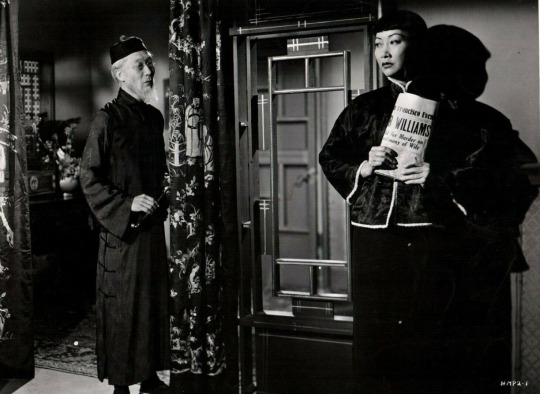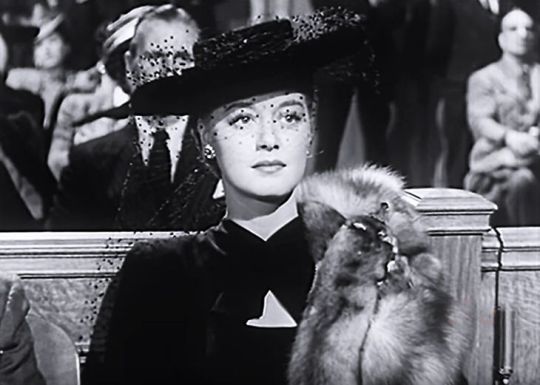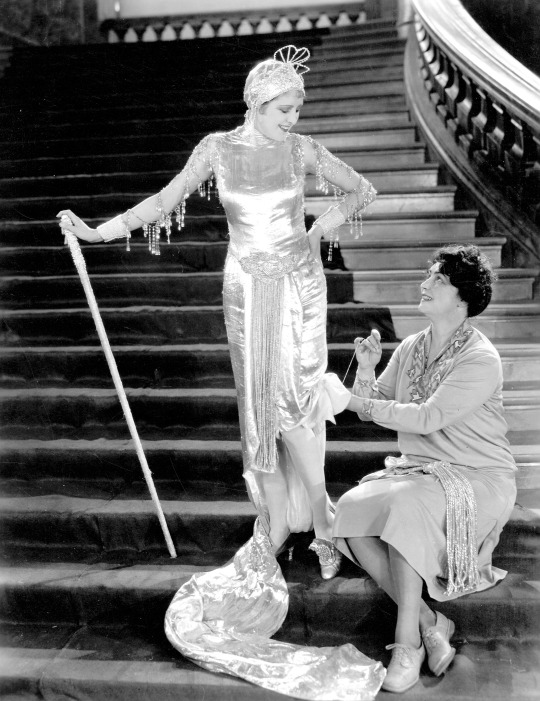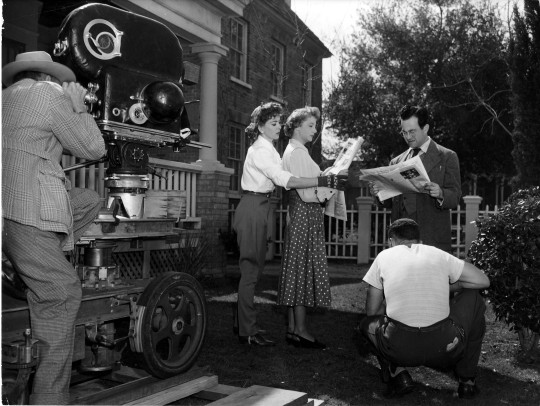#Dorothy Davenport Reid
Explore tagged Tumblr posts
Text

(Original caption) Wallace Reid, Paramount star, his wife, formerly Dorothy Davenport, and their son William Wallace Reid Jr., otherwise known as Bill, at the door of their Hollywood home, circa 1920.
82 notes
·
View notes
Photo

Dorothy Davenport and Wallace Reid (the latter channeling Sherlock Holmes with his violin).
Source
4 notes
·
View notes
Text






The Woman Condemned (1934) Dorothy Davenport
November 3rd 2024
#the woman condemned#1934#dorothy davenport#claudia dell#richard hemingway#lola lane#jason robards sr.#mischa auer#mrs. wallace reid#pre-code
0 notes
Text
Impact



“Charming” isn’t a word normally associated with film noir, yet it fits Arthur Lubin’s IMPACT (1949, TCM, Tubi, Plex, Prime, YouTube). From the intricate plot in which everything falls neatly into place to the location photography in San Francisco and Larkspur, CA, to, most importantly, the not quite love scenes between Brian Donlevy and Ella Raines, it’s an ongoing delight. Wealthy industrialist Donlevy is driving to Denver for a plant opening when his wife (Helen Walker) contrives to have her lover go along for the ride and kill him. The lover is neither very good with a tire iron nor with a steering wheel and ends up dead in a fiery car crash while Donlevy, stunned to discover what the Mrs. had been doing, wanders the countryside until he winds up at war widow Raines’ filling station. Romance is as inevitable as Hollywood usually makes it. Meanwhile, police detective Charles Coburn, in one of his least fussy performances, tries to make sense out of the plot.
With lots of scenes shot on location (including the same San Francisco hotel where Kim Novak’s character stayed in VERTIGO), IMPACT is a lot sunnier than most film noirs, but the plot is so twisted and Walker such a great femme fatale it doesn’t matter. The script, by Dorothy Davenport (that’s Mrs. Wallace Reid to you) is a masterpiece of efficiency, with key facts and events planted effortlessly and events communicated through telegrams, newspaper headlines and even a radio broadcast by gossip columnist Sheilah Grahame. Raines was never distinctive enough to be a star, but she’s a darned good actress and lots better than you’d expect from a film noir good woman. Donlevy, whose leading man days were largely over by 1949, has beautiful moments as he realizes what’s going on in his life. Anna May Wong deserved a lot better than her brief role as Walker’s maid, but she delivers a solid performance in her next-to-last film. Her friend (and merkin?) Philip Ahn is on-hand in old-age makeup as her uncle. You may also spot Robert Warwick as a police captain, Clarence Kolb as chairman of Donlevy’s board, silent great Mae Marsh as Raines’ mother, Jason Robards, Sr. as a judge, Erskine Sanford as a doctor and horror film standby Morris Ankrum as Donlevy’s assistant.
#film noir#arthur lubin#dorothy davenport#brian donlevy#ella raines#helen walker#anna may wong#charles coburn#robert warwick#clarnce kolb#mae marsh#jason robards#erskine sanford#morris ankrum
0 notes
Text
Crusading Cinema: Socially Conscious Female Directors By Kim Luperi
As TCM’s groundbreaking series has Women in Film illustrated, it wasn't only men who blazed the cinematic trail. The few female filmmakers in early Hollywood with the power to tell stories important to them used the medium to illuminate social issues. Here’s a look at three women who raised awareness – and sometimes hell – with their “social problem” films.
Lois Weber

Even when on vacation, Lois Weber was “planning problem pictures by which she hopes to lend her mite [sic] towards the education and uplift of humanity,” The Billboard conveyed. She sure delivered. Weber’s 1915 feature HYPOCRITES, in which a nude woman represents “The Naked Truth” to expose modern society’s hypocrisy, incurred the censors’ wrath – and made Weber a household name. The film’s box-office success secured Weber and her bold moral voice creative control over future films, and she embarked on a series of “preachment” pictures addressing divisive subjects, like sexual harassment (1915’s SUNSHINE MOLLY), capital punishment (1916’s THE PEOPLE VS. JOHN DOE), poverty and working women (1916’s Shoes) and abortion and birth control (1916’s WHERE ARE MY CHILDREN? and 1917’s THE HAND THAT ROCKS THE CRADLE). Her pictures performed so well that Weber commanded the highest annual salary of any director, male or female, in 1917.
Produced at the height of Margaret Sanger’s birth control crusade, WHERE ARE MY CHILDREN? proved contentious but successful; a Pennsylvania censor called it “unspeakably vile,” yet it ranked as Universal’s biggest moneymaker of 1916. A committee from the National Board of Review, unsure if they should allow it to screen, polled prominent community members, and a majority supported the exhibition for adults only. Though the director should be commended for encouraging discussion of such a controversial topic, Weber biographer Shelley Stamp points out that the movie makes a classist, eugenics argument, mirroring the movement at that time. Ultimately, WHERE ARE MY CHILDREN? supports birth control – for working class women only, upper class women should still reproduce – but ultimately denounces abortion.
Ida May Park
Many of Ida May Park’s pictures, including the 14 she helmed at Universal from 1917-1920 and many of the 50 features she scripted, center on women who rise from poverty or other desolate beginnings to cinch a fairytale ending. As Jackie Perez observed in When Women Wrote Hollywood, most of Park’s films are lost, but existing documentation informs us that while romance and love reigned supreme in her movies, Park also explored socially minded issues like forced marriage, neglectful spouses and harassment.
Park’s only directorial effort to survive, in fragment only, is BREAD (’18). Frequently compared to Weber’s Shoes, another societal-minded feature starring Mary MacLaren, BREAD follows a woman navigating the big city on her own and trying to make her dreams come true as she contends with issues of poverty, power imbalance and the manipulation she faces from men.
Dorothy Davenport Reid

Following the tragic January 1923 death of husband Wallace Reid from complications related to morphine addiction (initially prescribed by studio doctors after an accident), actress Dorothy Davenport Reid established her own production company for the sole purpose of creating socially conscious pictures. After attending a conference on narcotics, Mrs. Wallace Reid began work – uncredited as director and writer – on HUMAN WRECKAGE (’23), a now-lost film that frankly depicted drug usage and addiction.
As Karen Ward Mahar wrote in Women Filmmakers in Early Hollywood, Mrs. Reid was a “showman.” With alarming scenes intended to shock audiences and Reid appearing onscreen entreating viewers to help in the fight against narcotics, HUMAN WRECKAGE emerged as one of the first exploitation pictures. The movie performed well, particularly because Reid made in-person appearances at theaters and curious fans flocked to see what she crafted in her husband’s memory. Reid followed it up with BROKEN LAWS (’24), which explored juvenile delinquency and parental authority, and THE RED KIMONO (’25), about a woman tricked into prostitution. While The New York Times dismissed the latter as “intended to cause weeping, wailing and gnashing of teeth,” poor reviews were the least of Reid’s worries. Journalist Adela Rogers St. Johns based the source material for THE RED KIMONO on an actual trial she covered, but in dramatizing the case, she failed to change the real woman’s name. Thus, Gabrielle Darley successfully sued Reid for violating her privacy, forcing her to shutter her production company, though Reid continued producing for Poverty Row studios through the late 1930s.
The Supreme Court's landmark 1915 Mutual Film Corporation ruling denied movies protection under the First Amendment, prompting censorship legislation in several states and ultimately encouraging the industry to approach cinema as entertainment. However, the work of these three women, as well as others who explored divisive topics like Lule Warrenton (racial prejudice in 1916’s WHEN LITTLE LINDY SANG) and Ida Lupino (rape in 1950’s OUTRAGE), laid the groundwork for future female filmmakers to challenge and change minds through cinema.

#Female directors#women make film#Ida Lupino#Dorothy Davenport Reid#Ida May Pak#Lois Weber#silent film#TCM#Turner Classic Movies#Kim Luperi
60 notes
·
View notes
Photo

Mothers of Men (1917)
20 notes
·
View notes
Text

Wallace Reid and Dorothy Davenport
8 notes
·
View notes
Photo

The Early Women Filmmakers Blogathon, sponsored by our May 9th Blu-ray/DVD release EARLY WOMEN FILMMAKERS: AN INTERNATIONAL ANTHOLOGY, is live at Movies Silently! Enjoy the many articles posted about these groundbreaking directors: http://moviessilently.com/2017/03/27/the-early-women-filmmakers-blogathon-is-here/
#Early Women Filmmakers#blogathon#women in film#directed by women#women directors#female directors#Women's History Month#film history#classic film#silent film#animation#Alice Guy Blaché#Mabel Normand#Lotte Reiniger#Maya Deren#Claire Parker#Lois Weber#Dorothy Arzner#Dorothy Davenport Reid
2 notes
·
View notes
Text

Keystone Film Banquet, Feb. 17, 1915.
Top row, left to right: Mrs. M. Swain, Mrs. C. Conklin, Dorothy Davenport(Mrs. Wallace Reid), Miss Wallace, Mack Swain, Teddy Sampson, Ford Sterling, Charlie Murray, Ad Messel, Mrs. C. Murray
2nd row, left to right: Chester Conklin, Lottie Pickford, Minta Durfee, Roscoe Arbuckle, Mable Normand, and Mack Sennett
Front Row, left to right: A.L. Ries, Mrs. Alice Davenport, Phyllis Allen, Henry McCoy, Mrs. S. Chaplin, Sidney Chaplin, O.L. Veister.
#mack swain#chester conklin#dorothy davenport#alice davenport#ford sterling#teddy sampson#charlie murray#minta durfee#roscoe arbuckle#mack sennett#phyllis allen
5 notes
·
View notes
Photo

Wallace Reid (April 15, 1891 – January 18, 1923), he was drawn into the move making industry by his father, who throughout Wallace’s early life had been a playwright, however, with the dawn of film he switched to writing and directing films. Wallace showed promise from an early age in terms of acting, he frequently performed on stage as a young man, however, he left this behind to pursue an education at Freehold Military School.
It was after he graduated that his father drew him in, and in 1910 Wallace appeared in his first film, ‘The Phoenix.’ Though he had proven his ability to act, studios were more so interested in his sex appeal, capitalizing on his good looks and pairing him with megastars of the time such as Florence Turner and Elise Ferguson.
Having taken part in well over 100 roles by the time he was signed by Famous Players Film Company in 1919, Reid would go onto take part in over 60 more. The most notable were his pairings with Anne Little as a daring racecar driver. It would turn out a few years later, Reid would attempt to become a professional racecar driver, though he was unsuccessful.
Unfortunately, Reid does not have a very happy ending to his life.
It begins with him traveling to Oregon to film, ‘Valley of the Giants,’ (1919), while en route, his train crashed and he required several stitches to mend a head wound. To help with the pain, he was prescribed morphine. He became addicted, and began taking on roles that were increasingly more physically dependent. At the time, drug rehabilitation programs were non-existent.
He died in a sanitarium in Los Angeles that was known for the Baker Cure, just six weeks after admission in 1923.
His wife, Dorothy Davenport, produced ‘Human Wreckage’ in 1923, a film about the dangers of drug addiction. Until the mid-forties, there existed a strict self-censorship known as ‘the Haye’s Code,’ which states that there could not be any drug references in a film. However, due to the anti-drug message, Davenport was given an exception.
For his contribution to cinema, Reid was given a star on the Hollywood Walk of Fame.
3 notes
·
View notes
Text

The Reid family by the pool in 1920: Dorothy Davenport, Wallace Reid, Jr., and Wallace Reid
15 notes
·
View notes
Photo

Claudia Dell in The Woman Condemned (1934, dir. “Mrs. Wallace Reid,” aka Dorothy Davenport).
#claudia dell#the woman condemned#1934#1930s#30s#dorothy davenport#mrs. wallace reid#women in film#women filmmakers#women directors#female filmmakers#female directors#old hollywood
6 notes
·
View notes
Photo

The Red Kimona (1925) d. Walter Lang (poster from US)
Depending on which source you use you will find the film’s title to be either The Red Kimona or The Red Kimono. Mrs Wallace Reid (Dorothy Davenport) co-directed the film and as it states in the credits on the film, it was “Produced Under The Personal Supervision of Mrs Wallace Reid.” By the way, that is Mrs Wallace Reid on the poster. She opens and closes the film with a lengthy speech, sort of unusual for a silent film. She would look at the audience and ramble on and then there would be a cutaway to the title card and we would read what she just said to us that we couldn’t hear. The screenplay was written by future director Dorothy Arzner.
5 notes
·
View notes
Text
World Poll 2019
Great recent movies (made since 2014) seen for the first time in 2019
Mademoiselle de Joncquières (Emmanuel Mouret, 2018)
Dau Huduni Methai (Song of the Horned Owl, Manju Borah, 2015)
El Crack cero (José Luis Garci, 2019)
Jiang hu er nv (Ash is Purest White, Jia Zhang-ke, 2018)
Carré 35 (Plot 35, Éric Caravaca, 2017)
Sic transit Gloria Mundi (Gloria Mundi, Robert Guédiguian, 2019)
If Beale Street Could Talk (Barry Jenkins, 2018)
Ad Astra (James Gray, 2019)
Le Chant du loup (The Wolf’s Call, Antonin Braudy, 2019)
Shooting the Mafia (Kim Longinotto, 2019)
Village Rockstars (Rima Das, 2017)
Tantas Almas (Valley of Souls, Nicolás Rincón Gille, 2019)
Un peuple et son roi (Pierre Schoeller, 2018)
Aamis (Ravening, Bhaskar Hazarika, 2018/9)
Fishbone (Ad��n Aliaga, 2018)
O que arde (Fire Will Come, Oliver Laxe, 2019)
La Fin de la nuit (Lucas Belvaux, 2015)
Ramen Teh (Ramen Shop, Eric Khoo, 2018)
Light of My Life (Casey Affleck, 2019)
Great movies (made before 2014) seen for the first time in 2019
’49-’17 (Ruth Ann Baldwin, 1917)
Ba shan ye yu (Evening Rain / Night Rain of Mount Ba, Wu Yigong and Wu Yonggang, 1980)
The Spirit of the Flag (Allan Dwan, 1913)
Versailles (Pierre Schoeller, 2008)
Ùn pienghjite mica (Les Anonymes, Pierre Schoeller, 2012/3)
Foxfire (Joseph Pevney, 1954/5)
Johnny Come Lately (William K. Howard, 1943)
I girovaghi (Hugo Fregonese, 1956)
Nunal sa Tubig (Speck in the Water, Ishmael Bernal, 1976)
Ikaw ay Kin (You Are Mine, Ishmael Bernal, 1978)
Pervyí eshielon (The First Convoy, Mikhail Kalatozov, 1955/6)
The Sea Wolf (Alfred Santell, 1930)
Surrender (William K. Howard, 1931)
The Restless Years (Helmut Käutner, 1958)
Darling, How Could You! (Mitchell Leisen, 1951)
Ko:Yad (A Silent Way, Manju Borah, 2012)
The Flame (John H. Auer, 1947)
Ernst Thälmann-Sohn seiner Klasse (Kurt Maetzig, 1954)
Ernst Thälmann-Führer seiner Klasse (Kurt Maetzig, 1955)
Bólshaia Sémia (A Big Family, Iosif Kheífits, 1954)
Circuit Carole (Emmanuelle Cuau, 1995)
Harvey (Henry Koster, 1950)
As It Is in Life (D.W. Griffith, 1910)
Abroad with Two Yanks (Allan Dwan, 1944)
Behind Office Doors (Melville W. Brown, 1931)
Lovin’ The Ladies (Melville W. Brown, 1930)
La Tarea o cómo la pornografía salvó del tedio y mejoró la economía de la familia Partida (Homework, Jaime Humberto Hermosillo, 1990/1)
A Modern Hero (G.W. Pabst, 1934)
Surrender (William K. Howard, 1931)
Jubilee Trail (Joseph Inman Kane, 1954)
Matinée (Jaime Humberto Hermosillo, 1976/7)
Linda (Mrs. Wallace Reid = Dorothy Davenport, 1928/9)
Die missbrauchten Lebesbriefe (Leopold Lindtberg, 1940)
Very good movies (made since 2014) seen for the first time in 2019
Photograph (Ritesh Batra, 2019)
The Mule (Clint Eastwood, 2018)
The Man Who Killed Hitler and Then The Bigfoot (Robert D. Krzykowski, 2018)
Frères ennemis (Close Enemies, David Oelhoffen, 2018)
L’Homme fidèle (A Faithful Man, Louis Garrel, 2018)
Pris de court (Not on My Watch, Emmanuelle Cuau, 2016)
Dolor y Gloria (Pain and Glory, Pedro Almodóvar, 2019)
Frost (Šerkšnas, Sharunas Bartas, 2017)
Vitalina Varela (Pedro Costa, 2019)
Da xiang xi di er zuo (An Elephant Sitting Still, Hu Bo, 2018)
Di qiu zui hou de ye wan (Long Day’s Journey Into Night, Bi Gan, 2018)
La Tenerezza (Tenderness, Gianni Amelio, 2017)
Fourteen (Dan Sallitt, 2019)
Bulbul Can Sing (Rima Das, 2018)
A Rainy Day in New York (Woody Allen, 2019)
Legado en los huesos (Fernando González Molina, 2019)
Ma vie dans l’Allemagne d’Hitler (My Life in Hitler’s Germany, Jérôme Prieur, 2018)
La Vie balagan de Marceline Loridan-Ivens (Yves Jeuland, 2018)
Gangbyeon Hotel (Hotel by the River, Hong Sang-soo, 2018)
The Wind (Emma Tammi, 2018)
Kothanodi (The River of Fables, Bhaskar Hazarika, 2015)
Dar Jostojoy-e Farideh (Finding Farideh, Azadeh Moussavi & Kourosh Ataee, 2018)
Sir (Rohena Gera, 2018)
El Proyeccionista (The Projectionist, José María Cabral, 2019)
Intemperie (Benito Zambrano, 2019)
Madre (Mother, Rodrigo Sorogoyen, 2017, short)
Three Identical Strangers (Tim Wardle, 2018)
Madre (Rodrigo Sorogoyen, 2019)
Very good movies (made before 2014) seen for the first time in 2019
A Life for a Kiss (Allan Dwan, 1912)
Futari de aruita iku haru aki (The Days We Spent Together, Kinoshita Keisukē, 1962)
The Necklace (D.W. Griffith, 1909)
Das Schiff der verlorenen Menschen (Ship of Lost Men, Maurice Tourneur, 1929)
The Broken Locket (D.W. Griffith, 1909)
Primrose Hill (Mikhaël Hers, 2007)
The Rejected Woman (Albert Parker, 1924)
El último malón (Alcides Greca, 1917)
Bullets for O’Hara (William K. Howard, 1941)
Le Récit de Rebecca (Paul Vecchiali, 1964)
La noche avanza (Night Falls, Roberto Gavaldón, 1952)
Over-Exposed (Lewis B. Seiler, 1956)
I rollerna tre (Christina Olofson, 1996)
Il Viale della Speranza (Dino Risi, 1953)
Because of You (Joseph Pevney, 1952)
1870/…Correva l’anno di grazia 1870 (Alfredo Giannetti, 1972)
Demi-tarif (Isild Le Besco, 2003)
L’Exercice de l’État (The Minister, Pierre Schoeller, 2011)
Cheng nan jiu shi (My Memories of Old Beijing / Old Stories of the Southern Part of the City, Wu Yigong, 1983)
Strangler of the Swamp (Frank Wisbar, 1945/6)
Sword in the Desert (George Sherman, 1949)
There’s Always Tomorrow (Too Late For Love;Edward Sloman, 1934)
East Side, West Side (Allan Dwan, 1927)
Le Départ (Damien de Pierpont, 1998)
Face aux fantômes (Jean-Louis Comolli, 2009)
The Eagle and the Hawk (Mitchell Leisen, credited to Stuart Walker, 1933)
Whirlpool (Roy William Neill, 1934)
The Animal Kingdom (Edgard H. Griffith; uc. George Cukor, 1932)
Le Passager (The Passenger, Éric Caravaca, 2005)
Razumov (Sous les yeux d’Occident) (Marc Allégret, 1936)
Banjo On My Knee (John Cromwell, 1936)
One Night of Love (Victor Schertzinger, 1934)
Enchantment (Robert G. Vignola, 1921)
Charell (Mikhaël Hers, 2006)
Men With Wings (William A. Wellman, 1938)
Delitto per amore (L’edera) (Augusto Genina, 1950)
Les Amants de Minuit/Les Amours de Minuit (Augusto Genina, 1930/1)
Human Cargo (Allan Dwan, 1936)
Up the Ladder (Edward Sloman, 1925)
Luxury Liner (Richard B. Whorf, 1948)
Surrender! (Edward Sloman, 1927)
The Judge (Elmer Clifton, 1948/9)
Turbión (Antonio Momplet, 1938)
Der Ruf (Josef von Báky, 1949)
Faubourg Montmartre (Raymond Bernard, 1931)
Träumerei (Harald Braun, 1944)
The Red Lantern (Albert Capellani, 1919)
El Paseíllo (Ana Mariscal, 1968)
La quiniela (Ana Mariscal, 1960)
Great movies growing up or just rediscovered in 2019
Letter of Introduction (John M. Stahl, 1938)
Only Yesterday (John M. Stahl, 1933)
Our Wife (John M. Stahl, 1941)
Wohin und zurück (Axel Corti, 1982-6)
Giorno per giorno, disperatamente (Alfredo Gianetti, 1961)
Die wunderbare Lüge der Nina Petrowna (Hanns Schwarz, 1929)
Alyonka (Boris Barnet, 1961)
Craig’s Wife (Dorothy Arzner, 1936)
Imitation of Life/Fannie Hurst’s “Imitation of Life” (John M. Stahl, 1934)
Captains Courageous (Victor Fleming, 1937)
Test Pilot (Victor Fleming, 1938)
The Eternal Sea (John H. Auer, 1955)
Hello, Sister! (Anonymous: Erich von Stroheim, Alfred L. Werker, Raoul Walsh, Alan Crosland, 1933)
La noche de enfrente (Night Across the Street, Raúl Ruiz, 2012)
Journey into Light (Stuart R. Heisler, 1951)
Feel My Pulse (Gregory LaCava, 1928)
La signora senza camelie (The Lady Without Camelias, Michelangelo Antonioni, 1953)
Nosotros que fuimos tan felices (Antonio Drove, 1976)
Very good movies improved
Liana (Boris Barnet, 1955)
L’Avventura (Michelangelo Antonioni, 1960)
Du haut en bas (High and Low, G.W. Pabst, 1933)
Amok (Antonio Momplet, 1944)
The Man Who Never Was (Ronald Neame, 1956)
Open Range (Kevin Costner, 2003)
Con la vida hicieron fuego (Ana Mariscal, 1959)
Timberjack (Joe Kane, 1954/5)
En la Palma de tu Mano (Roberto Gavaldón, 1951)
Gravity (Alfonso Cuarón, 2013)
Expreso de Andalucía (Francisco Rovira-Beleta, 1956)
El Camino (Ana Mariscal, 1963)
La viuda del capitán Estrada (José Luis Cuerda, 1991)
Vestida de azul (Antonio Giménez-Rico, 1983)
Segundo López aventurero urbano (Ana Mariscal, 1953)
Hell’s Outpost (Joe Kane, 1954)
Fuente: http://sensesofcinema.com/2020/world-poll/world-poll-2019-part-5/#4
3 notes
·
View notes
Photo

1916 Dorothy Davenport Reid (recently married Wallace Reid) and her pets. From “Motion Picture Classic”.
16 notes
·
View notes
Photo

Remembering Wallace Reid who passed away 95 years ago on January 18, 1923. Here photographed with Eileen Percy (right) and Anita Loos (left) in 1917.
Wally's death at the age of 31 was caused by morphine addiction. Drug rehabilitation programs were then nonexistent and he died in a sanitarium while attempting recovery.
Wally’s two children, Bill and Betty, do not know yet that their big playfellow will never return. They think Daddy has “gone on location” and they have not been told what a long, long trip it will be. ��� Photoplay magazine, April 1923
Everyone has been so kind to me. They have commended my struggle, symphatized with me and my grief. But from every class — from legislators, from statesmen, from men and women who for years have been fighting this evil — comes the cry: “Do something. They will listen to you. They loved Wally and they admired his brave fight and they hate the thing that killed him. Tell them what you know for the good of humanity.” — Dorothy Davenport Reid, 1923
The motion pictures have lost an artist who held a unique place in the hearts of the patrons of the screen. We have lost one of our brightest stars. — Jesse L. Lasky
42 notes
·
View notes